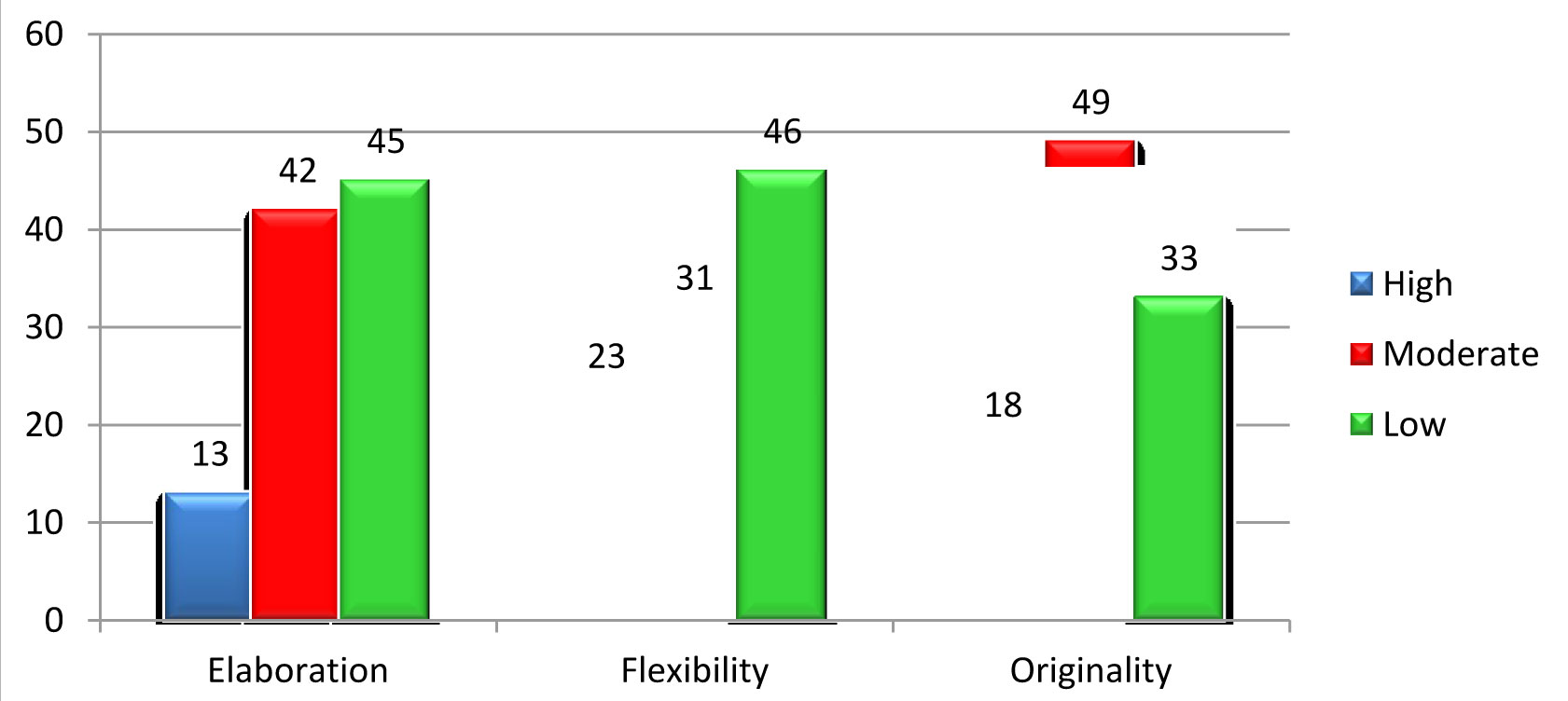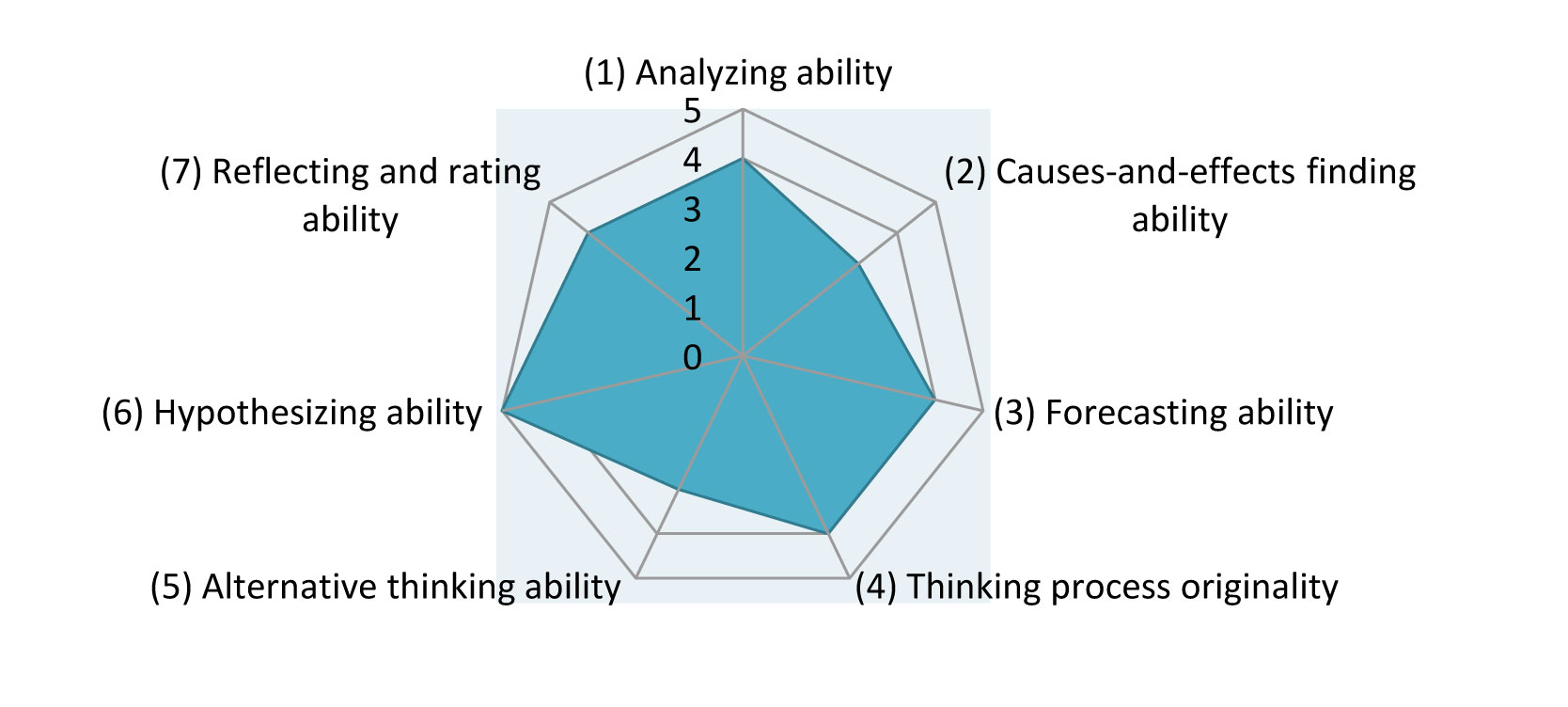Creativity-driven ecological thinking development in physical culture and sport university students
Фотографии:
ˑ:
PhD, Professor E.A. Grineva1
Dr.Hab., Professor V.G. Shubovich1
PhD, Associate Professor N.V. Bibikova1
1Ulyanovsk State Pedagogical University n.a. I.N. Ulyanov, Ulyanovsk
Keywords: environmental education, ecological thinking, creativity, flexibility, elaboration, originality.
Background. As things now stand in the national academic educational system, the universities feel the need in the professional education system being reformed so as to give a top priority to the flexible thinking capacity development aspect to improve the students’ adaptability to the fast changing social and natural environmental factors. To put it in other words, the post-reform generation of university specialists is expected to have well-developed ecological thinking skills. Ecology as the educational process design basis for sustainable development may be defined as the mega-science (or combined scientific thrust) driven by a consistent methodology and designed to build up, in a staged manner, an efficient ecological thinking toolkit [5, p. 308].
It should be mentioned that the public consciousness has lagged behind the social practices so far, particularly in the natural environment transformation domain; and the poorly controlled transformations, as a result, have largely and increasingly damaged the biosphere of the planet. Therefore it is important to have at least some leadership of the public consciousness secured in future that should direct the social existence to more efficient and constructive ways of survival [4, p. 243]. In the context of the ecological thinking meaning and definition, it shall be formed in parallel with the personal creativity building process – which in its turn is determined by a variety personality qualities including elaboration, flexibility and originality.
Objective of the study was to analyze progress of the creativity-driven ecological thinking development process in application to physical culture and sport university students, with the progress rated by the creativity and ecological thinking rating tests and test data correlation analysis.
Methods and structure of the study. Subject to the study were the first- to fourth-year students (n=65) of the Physical Education and Sports Department of Ulyanovsk State Pedagogical University named after I.N. Ulyanov, with the relevant theoretical and empirical test methods (including Ward’s and K-means clustering methods) applied in the study. The test toolkit included the B.P. Torrance Tests of Creative Thinking and the Ecological Thinking Profiling Test designed by the authors.
Study results and discussion. The study gave the means to offer theoretical provisions for the creativity-driven ecological thinking development process in the academic education. The ecological thinking development process shall be designed on the sound theoretical logics with the following: sound humanitarian and humanistic values, with the environmental protection issues being in top priority; full awareness of the global environmental crisis; and necessary changes in the world outlooks and values-driven reference points [3].
It is important that the modern ecological thinking is designed to channel the intellectual resource to address the environmental problems and solutions in the context of the human production and consumption processes; and that is why the ecological thinking development options are most efficient when driven by well-developed constructive creativity. Experimental tests under the study were designed to rate individual elaboration, flexibility and originality viewed as the core creativity qualities. Given on Figure 1 hereunder are the averaged test data (in %) for the sample.

Figure 1. Creativity test data
The above test data show domination of the low thinking elaboration and flexibility rates, with the thinking originality ranked moderate for the sample. This finding shows the need for the modern educational technologies to be complemented by efficient creativity-developing methods, all the more that the valid Federal State Education Standards (FSES) for 44.03.05 Pedagogical Education disciplines require the general cultural competences including the relevant philosophical and socio-humanitarian competences being developed in the students in their scientific world outlooks cultivation process (General Competences 1, GC-1).
For the ecological thinking analyzing purposes, we applied the Ecological Thinking Profiling Test of our own design. The ecological thinking capacity may be classified into the following elements: (1) analyzing ability; (2) causes-and-effects identification ability; (3) forecasting ability; (4) thinking process originality; (5) alternative thinking flexibility; (6) hypothesizing ability; and (7) reflecting and rating ability. Each of the above ecological thinking elements was rated on a five-point scale as follows: 5 points for the well-developed and expressed ecological thinking elements manifested in every operation and behavioural pattern; 4 points for the good albeit imbalanced/ situational ecological thinking element; 3 points for the satisfactory/ occasional manifestations of the ecological thinking element; 2 points when the subject’s ecological thinking element is poorly developed; and 1 point when the subject’s ecological thinking element is still undeveloped.
In order to rate and visualize the individual ecological thinking elements, every student was required to design his/her individual profile based on an ecological thinking template. The template offers 5 vectors each scored by the 5-point scale as explained above. The generalized ecological thinking profiling data for the sample are given on Figure 2 hereunder.

Figure 2. Generalized ecological thinking profiling data
(1) Analyzing ability (2) Causes-and-effects finding ability (3) Forecasting ability (4) Thinking process originality (5) Alternative thinking ability (6) Hypothesizing ability (7) Reflecting and rating ability
In the ecological thinking ability test data interpretation, we should note that the sample was tested high only in the hypothesizing ability, with all the other ecological thinking elements mostly tested moderate that means that the ecological thinking abilities are largely underdeveloped in the sample.
Furthermore, we rated the creativity test rates versus the ecological thinking elementary rates to find possible correlations. Given in Table 1 hereunder are the creativity test rates (Elaboration, Flexibility and Originality) versus the above ecological thinking elementary rates (VM_1 to VM_7).
Table 1. Creativity test rates versus ecological thinking rates correlation matrix
|
Correlations (Creativity_vectorz.sta); Marked correlations are significant at p < 0.01000 N=65 (Casewise deletion of missing data) |
||||||||||
|
Creativity rates |
El |
Flex |
Orig |
VM_1 |
VM_2 |
VM_3 |
VM_4 |
VM_5 |
VM_6 |
VM_7 |
|
Elaboration |
1,000 |
0,580 |
0,780 |
0,884 |
0,766 |
0,588 |
0,579 |
0,748 |
0,814 |
0,626 |
|
Flexibility |
0,580 |
1,000 |
0,746 |
0,560 |
0,692 |
0,768 |
0,660 |
0,578 |
0,642 |
0,654 |
|
Originality |
0,780 |
0,746 |
1,000 |
0,758 |
0,787 |
0,601 |
0,839 |
0,787 |
0,809 |
0,672 |
|
VM_1 |
0,884 |
0,560 |
0,758 |
1,000 |
0,856 |
0,737 |
0,731 |
0,864 |
0,924 |
0,769 |
|
VM_2 |
0,766 |
0,692 |
0,787 |
0,856 |
1,000 |
0,712 |
0,677 |
0,761 |
0,854 |
0,775 |
|
VM_3 |
0,588 |
0,768 |
0,601 |
0,737 |
0,712 |
1,000 |
0,687 |
0,762 |
0,692 |
0,885 |
|
VM_4 |
0,579 |
0,660 |
0,839 |
0,731 |
0,677 |
0,687 |
1,000 |
0,768 |
0,808 |
0,785 |
|
VM_5 |
0,748 |
0,578 |
0,787 |
0,864 |
0,761 |
0,762 |
0,768 |
1,000 |
0,747 |
0,726 |
|
VM_6 |
0,814 |
0,642 |
0,809 |
0,924 |
0,854 |
0,692 |
0,808 |
0,747 |
1,000 |
0,791 |
|
VM_7 |
0,626 |
0,654 |
0,672 |
0,769 |
0,775 |
0,885 |
0,785 |
0,726 |
0,791 |
1,000 |
The study data and analyses found the above rates being in significant correlations: for instance, the Originality to Elaboration correlation ratio was estimated at 0.78, the value being significant at р=0.01. The Originality (creative thinking) rate was also found correlating with all other thinking elements including the forecasting ability (VM_3) and thinking originality (VM_4) in the above vector matrix. We also found the following most informative non-correlating thinking ability aspects being most efficient for the classification purposes: ecological thinking process elaboration, flexibility, forecasting and analyzing abilities, and alternative thinking ability.
For the ecological thinking capacity building purposes, the university faculty shall prudently combine the relevant modern educational technologies, methods and models [7, p. 103] with due contributions from the problem-solving and cognitive creativity cultivating education formats; and with the trainees being widely engaged in the relevant environmental projects, socio-ecological trainings, eco-quests and other creative environment-sensitive education formats. We share the Y.N. Dzyatkovskaya belief that the existing barriers on the way to these education formats effectively slow down the environmental education advancement initiatives [3]. The existing and new curricula of the academic physical education and sports departments shall be complemented with the new knowledge about the mankind’s relationship with natural environments including basics of modern environmental philosophy.
Conclusion. The environmental education may be efficient enough if supported by the creativity-driven ecological thinking development process. This thinking shall help overcome the still dominating formalism in the national environmental education associated with the still poor environmental education competency of the education specialists on the whole and the physical education and sports specialists in particular.
The study was supported by the research grant financing from the Russian State Research Fund under Project #16-16-73002а
References
- Bibikova N.V. Grineva E.A. Innovatsii v ekologicheskom obrazovanii: kontekst kreativnosti. Ucheb.-metod. posobie [Innovations in environmental education: creativity context. Study guide]. Ulyanovsk: UlSPU publ., 2016, 76 p.
- Bibikova N.V., Grineva E.A. Formirovanie ekologicheskogo mirovozzreniya obuchayuschikhsya v obrazovatelnom protsesse: diagnosticheskiy aspekt [Formation of students' ecological outlook in educational process: diagnostic aspect]. Uspekhi sovremennoy nauki i obrazovaniya, 2017, no. 2 (1), pp. 9–13.
- Dzyatkovskaya E.N. O ponyatiyno-terminologicheskom apparate ekologicheskogo obrazovaniya [Definitions of environmental education]. Ekologicheskoe obrazovanie: do shkoly, v shkole, vne shkoly, 2012, no. 1.
- Ilyin I.V., Ursul A.D. Obrazovanie, obschestvo, priroda: Evolyutsionny podkhod i globalnye perspektivy [Education, society, nature: Evolutionary approach and global perspectives]. Moscow: Moscow university publ., 2016, 556 p.
- Nikitin A.T., Stepanov S.A. O neobkhodimykh chertakh tsivilizatsii buduschego (nauchnoe izdanie po materialam Mezhdunarodnogo foruma, posvyaschennogo 90-letiyu so dnya rozhdeniya vydayuschegosya rossiyskogo uchenogo akademika RAN N.N. Moiseeva) [Essentials features of civilization to come (scientific edition based on proc. International Forum dedicated to the 90th anniversary of outstanding Russian scientist RAS N. Moiseev)]. Moscow: MNEPU publ., 2008, 502 p.
- Soltakhmadova L.T. Formirovanie ekologicheskogo myshleniya lichnosti [Formation of individual ecological thinking]. Problemy sovremennogo pedagogicheskogo obrazovaniya, 2016, no. 53(5), pp. 209-215.
- Chernetskaya Zh.N. Analiz smysla ponyatiya «ekologicheskoe myshlenie» kak metapredmetnogo obrazovatelnogo rezultata [Analysis of the meaning of ecological thinking concept as metadisciplinary educational result]. Pedagogicheskoe obrazovanie i nauka, 2017, no. 1, pp. 98-105.
- Shubovich V.G. Metodika otsenki slozhnosti vektora priznakov obraza [Image characteristics vector complexity rating method]. Collection of technical-scientific works. Ulyanovsk branch MALT publ., Ulyanovsk, 2000, pp. 68-78.
- Shubovich V.G., Chernetskaya V.G. Metodika ispolzovaniya klasternogo analiza dlya resheniya zadachi klassifikatsii ob'ektov [Cluster analysis application technique for object classification]. Collection of technical-scientific works. Ulyanovsk branch MALT publ., Ulyanovsk, 2000. pp. 89-96.
Corresponding author: eliz.grin9@yandex.ruAbstract
Objective of the study was to analyze progress of the creativity-driven ecological thinking development process in application to physical culture and sports university students, with the progress rated by the creativity and ecological thinking rating tests and the test data correlation analysis. Subject to the study were the first- to fourth-year students (n=65) of the Physical Education and Sports Department of Ulyanovsk State Pedagogical University named after I.N. Ulyanov, with theoretical and empirical test methods (including the Ward’s and K-means clustering methods) applied in the study. The test toolkit included the B.P. Torrance Tests of Creative Thinking and the Ecological Thinking Profiling Test designed by the authors. The experimental study data and analysis gave the means to rate a variety of qualities including ecological thinking process elaboration and flexibility; forecasting ability; analyzing ability; and alternative thinking ability.




